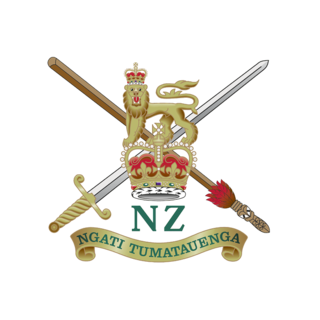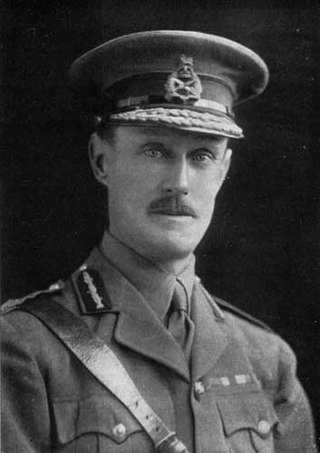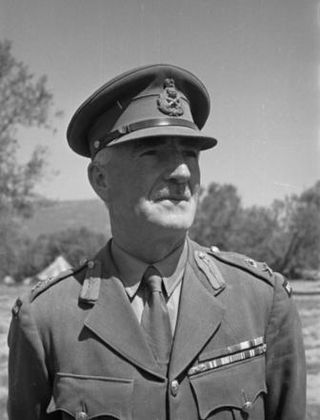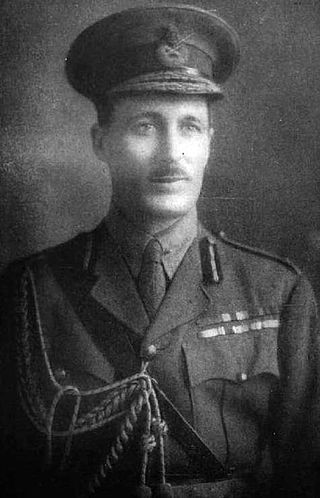
The New Zealand Expeditionary Force (NZEF) was the title of the military forces sent from New Zealand to fight alongside other British Empire and Dominion troops during World War I (1914–1918) and World War II (1939–1945). Ultimately, the NZEF of World War I became known as the First New Zealand Expeditionary Force. The NZEF of World War II was known as the Second New Zealand Expeditionary Force (2NZEF).

The New Zealand Army is the principal land warfare force of New Zealand, a component of the New Zealand Defence Force alongside the Royal New Zealand Navy and the Royal New Zealand Air Force.

The Royal Regiment of New Zealand Artillery is the artillery regiment of the New Zealand Army. It is effectively a military administrative corps, and can comprise multiple component regiments. This nomenclature stems from its heritage as an offshoot of the British Army's Royal Artillery. In its current form it was founded in 1947 with the amalgamation of the regular and volunteer corps of artillery in New Zealand. In 1958 in recognition of services rendered it was given the title the Royal Regiment of New Zealand Artillery.

The Corps of Royal New Zealand Engineers is the administrative corps of the New Zealand Army responsible for military engineering. The role of the Engineers is to assist in maintaining friendly forces' mobility, deny freedom of movement to the enemy, and provide general engineering support. The corps has been involved in numerous conflicts over the course of its history including World War I, World War II, the Korean War, the Vietnam War and the war in Afghanistan. The corps consists of a single regiment, 2nd Engineer Regiment, primarily based at Linton Military Camp near Palmerston North.
The Otago and Southland Regiment (1948-2012) was a Territorial Force unit of the New Zealand Army. It saw service from 1959-1963 during the Malayan Emergency. In 1964 the unit was renamed the 4th Otago and Southland Battalion Group. The Regiments motto was Kia Mate Toa and Regimental Belt had the Mackenzie Tartan pattern of the Queen's Own Highlanders. The regimental badge uniquely contained a full Māori chief.
Lieutenant Colonel William George Malone was an officer in the New Zealand Expeditionary Force who served in the First World War. He commanded the Wellington Infantry Battalion during the Gallipoli Campaign, and was killed in action by friendly fire during the Battle of Chunuk Bair.

General Sir Alexander John Godley, was a senior British Army officer. He is best known for his role as commander of the New Zealand Expeditionary Force and II Anzac Corps during the First World War.

The military history of New Zealand during World War I began in August 1914. When Britain declared war on Germany at the start of the First World War, the New Zealand government followed without hesitation, despite its geographic isolation and small population. It was believed at the time that any declaration of war by the United Kingdom automatically included New Zealand; and the Governor announced that New Zealand was at war with Germany from the steps of Parliament on 5 August.

Major General Sir Harold Eric Barrowclough & Bar, was a New Zealand military leader, lawyer and Chief Justice from 1953 to 1966.

Lieutenant General Sir Edward Puttick, was an officer who served with the New Zealand Military Forces during the First and Second World Wars. The first New Zealand-born soldier to reach the rank of lieutenant general, he was Chief of the General Staff of the New Zealand Military Forces from 1941 to 1945.

Major General Sir Alfred William Robin, was a New Zealand military leader.

Major General Sir Keith Lindsay Stewart, was a professional soldier in the New Zealand Military Forces. He served during the First and Second World Wars and was Chief of the General Staff of the New Zealand Military Forces from 1949 to 1952.
John Gethin Hughes was a New Zealand military leader. Born in Bluff, Southland, New Zealand, he served in the Boer War with the First Contingent of the New Zealand Volunteer Force to be sent to South Africa. During the war he was the first New Zealand recipient of the Distinguished Service Order. After the war he became a professional soldier and served in a number of staff positions in the New Zealand Military Forces. A member of the New Zealand Expeditionary Force during the early stages of the First World War, he commanded the Canterbury Battalion during the Gallipoli Campaign. He was eventually evacuated from Gallipoli late in the campaign for medical reasons. He retired from the military in 1917 due to poor health and died in 1954 at the age of 88.

Brigadier General Sir Herbert Ernest Hart, was an officer in the New Zealand Military Forces who served during the Second Boer War and the First World War. He later served as the Administrator of Western Samoa and worked for the Imperial War Graves Commission.

Major General Sir John Evelyn Duigan, was an officer who served with the New Zealand Military Forces during the First and Second World Wars. He was Chief of the General Staff of the New Zealand Military Forces from 1937 to 1941.

Major General Charles William Melvill, was a soldier who served with the British Army for several years before joining the New Zealand Military Forces. He participated in the First World War with the New Zealand Division and commanded infantry brigades on the Western Front. When he died, he was Commandant of the New Zealand Military Forces.

Major General Sir Norman William McDonald Weir, was a professional soldier in the New Zealand Military Forces. He served during the First and Second World Wars, and was Chief of the General Staff of the New Zealand Military Forces from 1946 to 1949.

Major General Owen Herbert Mead, was an officer in the New Zealand Military Forces who served during the First and Second World Wars.
Brigadier Robert Amos Row, was a senior officer in the New Zealand Military Forces and a two-time recipient of the Distinguished Service Order. He served in the New Zealand Expeditionary Force during the First World War, commanding an infantry battalion. In the Second World War, he commanded the 8th Brigade during the Battle of the Treasury Islands.














